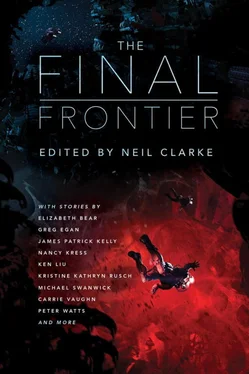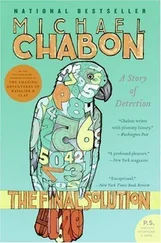Jackson put up a blurred image of the shield pulling away from the Argo.
“It looks undamaged,” I said.
“I assumed that the damage was on the other side. Now I realize that the explosive separation bolts had been fired. There had been no collision.”
“Was there any communication between the shield and the Argo?”
“When we transmitted the kill switch key to take manual control of the shield, all we got was the INVALID KEY response. That indicates catastrophic damage.”
“Did you try to pursue?”
“The instrument section of the Argo has no ion thrusters, they were all built into the shield. We decided to use the rockets of the Harpy probes to push the Argo further away from Centauri A, and at least salvage something of the mission.”
“Thank you Control-Captain, that will be all for now.”
Ashcroft was escorted to the stand. It was the first time I had seen him, because he had managed to stay out of the holovista coverage. He had a closely shaven scalp and a bushy white beard. It looked to me as if his head were upside down, and I had to stifle the urge to laugh.
“Lieutenant Charles Ashcroft, you were the Mission Continuity and Disaster Recovery officer until you were arrested,” I said, looking up from my UDP.
“That’s right, Your Honor.”
His accent was west coast. Ashcroft was the same age as Jackson, and the difference in their rank was due to the fact that Ashcroft was extremely good at what he did, and was not interested in learning to do those other things that got one promoted—like handling difficult staff, raising funds, and flattering important people with influence.
“Please describe your role in the Argo’s crew, using your own words,” I said.
“There’s an emergency processor in the shield where a virtual image of my consciousness is continually mirrored. If the main entanglement link shuts down, the emergency circuit activates Ashcroft-virtual. It’s completely autonomous, and can recover a functional subset of Argo systems unless the damage is catastrophic—”
“Enough, slow down,” I said, already familiar with his type after three decades of technical hearings crammed with geeks trying to blind me with science. “You say your mind was mirrored into a processor on the Argo, so a virtual image of your consciousness was actually aboard the probe itself. Am I correct?”
Ashcroft suddenly looked uneasy. I was the sort of legalistic pedant he despised, yet I was throwing his jargon back at him, and in coherent English. He cowered visibly, as if aware that a predator was nearby, and that he was small, fluffy and delicious.
“You’re correct, sir—that is, Your Honor,” he said sheepishly.
“And how many others have their virtuals mirrored aboard the Argo?”
“Just me, Your Honor.”
“So while the Argo was in recovery mode, your Ashcroft-virtual had sole command?” I asked.
“Yes, Your Honor.”
“I have made a study of the Argo’s systems,” I said as casually as I could. “Because the nature of disaster is by its very definition, unexpected, there was a manual emergency switch available to your virtual. If an emergency that could not possibly have been anticipated were to take place and cut off communications, Ashcroft-virtual could assess the situation and take action.”
Until now Ashcroft had not actually admitted to sabotaging the probe. However, he looked about as guilty as a dog on a kitchen table with the remains of a chicken pie. I did not know why he was delaying the inevitable, but I decided to give him a nudge.
“I put it to you, Lieutenant Ashcroft, that your virtual could easily have activated a meteor strike simulation routine, and so cut off the Argo from Mission Control. After that, Ashcroft-virtual had sole command of the probe. It would have been easy to fire the release charges to separate the shield of the Argo from its electronics, powerplant and scientific instruments.”
“Oh, yeah, but there you’re wrong. The on-board logs would have showed that the emergency was declared before the separation charges were fired.”
“So you fired the charges first.”
“I—”
His hesitation said everything. He was proud of how well he had covered his trail, so he wanted someone to know. Just as dragons have a soft spot in every fairy story, so too does every geek who has achieved some illegal technical master stroke.
“I suppose I can admit that now.”
“So, the Argo colliding with a speck of dust at a tenth of lightspeed would look identical to the separation charges being fired. You wanted to keep that part secret until after the Wells and Centauri A flybys.”
“You’re good,” Ashcroft conceded.
“I could charge you with contempt for that remark,” I said sternly. “Remember that if you are tempted to make another.”
“I’m sorry, Your Honor.”
That earned me seventeen million Spacebook dislikes and fifteen million likes. Public opinion was divided, but beginning to favor Ashcroft. Most viewers were still not voting.
“What is the significance of ‘firewall’?” I asked.
“The shield is no longer just a part of the Argo. Its name is the Firewall.”
“The Firewall. Your name for it?”
“The Firewall is the name that my virtual calls it.”
During a break I was shown a mockup of the Argo in a laboratory within the Mission Control building. The mockup was used to diagnose faults on the real starship and try to work out solutions. The Argo’s shield was shaped like a sleek, hollow axe head. Any fleck of dust that struck it would give just a glancing blow. Of course at nine percent of lightspeed even glancing blows were liable to be catastrophic, but it was the best design that anyone could think of.
The list of charges that was developing against Ashcroft would be good for decades of litigation. Overall, he had destroyed intersystem property costing four hundred trillion dollars, and worth even more in replacement value. Every media outlet in the solar system was linked to the auditorium’s cameras, and I knew that my face would be instantly recognizable by pretty well everyone for the rest of my life. According to my UDP’s scan of Spacebook, Ashcroft was currently both the most liked and the most disliked man in the solar system.
I faced the holocameras, trying not to think of how many pairs of eyes were behind them.
“Now, summing up the findings so far, Lieutenant Ashcroft has admitted to plotting to take control of the Argo ever since the mission began. He knew that Ashcroft-virtual would be in control of the Argo after any collision, real or simulated. Aboard the shield was enough computer power to support his virtual, so Ashcroft-virtual detached the shield. When the Argo went into lock-down for the Centauri A flyby, he fired the shield’s ion thrusters and put it on a course that would go deep into the star’s atmosphere for an extreme aerobrake. I must emphasize that it was Ashcroft-virtual that hijacked the shield while the Argo was cut off. Quite probably Ashcroft-original was an accomplice, however, because he had known the shield’s course.”
I called Jackson back to the stand. She looked very angry, in fact barely in control. Anger was always a dangerous emotion to display to Spacebook voters, as it generally attracted more dislikes than likes. She was not on trial, but a high dislike-to-like ratio would affect her reliability index as a witness. I started with the physics of the flyby.
“So instead of just swinging close to the star Centauri A to change course for the Gliese system, the shield fired its ion thrusters and did an extreme aerobrake deep into the star’s atmosphere. There it lost over half of its velocity, and changed course for Centauri B—where it will do another aerobrake, then fly on to the planet Wells.”
Читать дальше












